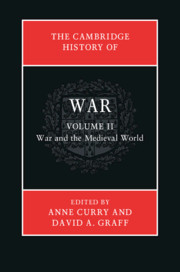Book contents
- The Cambridge History of War
- The Cambridge History of War
- Copyright page
- Contents
- Illustrations
- Maps
- Notes on contributors
- Introduction to volume II
- Part I Foundations, c.600–1000 ce
- Part II Interactions, c.1000–1300 ce
- 9 Europe, 1000–1300
- 10 Crusaders and settlers in the East, 1096–1291: Christian attack, Muslim response
- 11 The Mongol empire
- 12 China, 900–1400
- Part III Nations and Formations, c.1300–1500 ce
- Part IV Comparisons: Cross-Cultural Analysis
- Select bibliography
- Index
12 - China, 900–1400
from Part II - Interactions, c.1000–1300 ce
Published online by Cambridge University Press: 25 September 2020
- The Cambridge History of War
- The Cambridge History of War
- Copyright page
- Contents
- Illustrations
- Maps
- Notes on contributors
- Introduction to volume II
- Part I Foundations, c.600–1000 ce
- Part II Interactions, c.1000–1300 ce
- 9 Europe, 1000–1300
- 10 Crusaders and settlers in the East, 1096–1291: Christian attack, Muslim response
- 11 The Mongol empire
- 12 China, 900–1400
- Part III Nations and Formations, c.1300–1500 ce
- Part IV Comparisons: Cross-Cultural Analysis
- Select bibliography
- Index
Summary
The Tang dynasty (618–907) went into steep decline as a result of the Huang Chao Rebellion (874–84). The imperial government and the emperor himself became the tools of regional warlords, each maneuvering for his own power in an increasingly uncertain political and military milieu. These struggles were played out in the final decades of the Tang dynasty and beyond, lasting until the mid-point of the tenth century, when the various factions and power groupings of the late Tang had become so enervated by constant warfare and the deaths of the principal players that a new generation of ambitious power-seekers rose to the top. Steppe influence remained important in these conflicts and indeed, from the retrospective standpoint of the Jurchen Jin dynasty (1115–1234) and then the Mongol Yuan dynasty (1272–1368), the intervening control of north China by the Chinese Song dynasty (960–1279) almost seems to be the exception rather than the rule.
- Type
- Chapter
- Information
- The Cambridge History of War , pp. 322 - 346Publisher: Cambridge University PressPrint publication year: 2020



